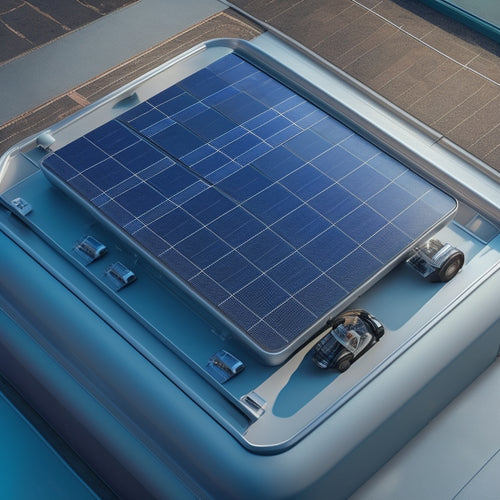
5 Ways to Safeguard Your Home Energy Storage
Share
To safeguard your home energy storage, start by implementing overcharge protection to prevent battery damage. Then, set up a temperature monitoring system to track fluctuations and prevent overheating. Maintain balanced charging cycles by keeping track of each battery's cycles and using smart charging algorithms. Prevent deep discharging damages by setting a lower threshold for state of charge and keeping track of charge and discharge cycles. Finally, sustain an ideal state of charge by calibrating your system regularly and monitoring consumption and production. By following these steps, you'll be well on your way to maximizing your system's lifespan and efficiency - and there's more to explore.
Key Takeaways
• Implement overcharge protection to prevent battery damage by monitoring state of charge and disconnecting the charging source when fully charged.
• Monitor temperature fluctuations to prevent excessive heat, which can reduce battery lifespan, by placing thermal sensors strategically.
• Ensure balanced charging cycles by keeping a record of each battery's cycles, identifying imbalances, and utilizing power optimization techniques.
• Prevent deep discharging damages by setting a lower threshold for state of charge and tracking charge and discharge cycles for battery calibration.
• Maintain an optimal state of charge by regularly calibrating the system, installing energy meters, and implementing a monitoring system to track state of charge.
Protecting Against Overcharging Risks
When you're setting up a home energy storage system, it's crucial to prioritize overcharge protection to prevent battery damage and potential safety hazards. Overcharging can lead to cell damage, reducing the lifespan of your energy storage system. To avoid this, you'll need to implement an overcharge detection system that can detect when your batteries are fully charged and prevent further charging.
A reliable overcharge detection system should be able to monitor the state of charge of your batteries and disconnect the charging source when they're fully charged. This ensures that your batteries are protected from overcharging, which can cause permanent damage to the cells.
Monitoring Temperature Fluctuations Effectively
You'll need to implement a temperature monitoring system that can accurately track temperature fluctuations in your home energy storage system, as excessive heat can greatly reduce the lifespan of your batteries. Thermal sensors can be strategically placed to monitor ambient conditions, guaranteeing that your batteries operate within a safe temperature range.
This is essential, as even slight deviations can affect performance and longevity.
By monitoring temperature fluctuations effectively, you can identify potential issues before they escalate into costly problems. For instance, if your system is consistently operating at high temperatures, it may indicate poor ventilation or inadequate cooling.
By addressing these issues promptly, you can prevent premature battery degradation and ensure peak performance.
To ensure accurate monitoring, consider investing in high-quality thermal sensors designed specifically for energy storage systems. These sensors can provide real-time data, enabling you to respond swiftly to temperature fluctuations.
Ensuring Balanced Charging Cycles
Imbalanced charging cycles can greatly diminish the lifespan of your home energy storage system, so it's crucial to implement a charging regimen that guarantees each battery is charged and discharged evenly. This guarantees that your system operates efficiently and effectively. To achieve balanced charging cycles, you'll need to monitor and control the charging process.
Here are some essential practices to keep in mind:
-
Cycle tracking: Keep a record of each battery's charge and discharge cycles to identify any imbalances. This data will help you adjust your charging regimen accordingly.
-
Power optimization: Implement power optimization techniques, such as load shifting and peak shaving, to reduce the strain on your batteries and prevent overcharging.
-
Smart charging algorithms: Utilize advanced charging algorithms that can detect and respond to changes in your energy usage, ensuring that your batteries are charged and discharged in a balanced manner.
Preventing Deep Discharging Damages
To prevent deep discharging damages, it's essential that you set a lower threshold for your home energy storage system's state of charge, ensuring that your batteries don't drop below a certain level, which can cause permanent damage. This threshold is critical, as deep discharging can reduce the lifespan of your batteries. By setting this threshold, you'll prevent your batteries from being overly drained, which helps maintain their overall health.
When it comes to cycle counting, it's important to keep track of how many charge and discharge cycles your batteries have gone through. This information helps you determine when it's time for battery calibration. Calibration ensures that your batteries are accurately reporting their state of charge, which is crucial for preventing deep discharging.
Maintaining Optimal State of Charge
Maintaining an essential state of charge is crucial, as it directly impacts the overall health and performance of your home energy storage system. As you work to safeguard your energy storage, it's important to understand the significance of maintaining an ideal state of charge.
To guarantee your system operates efficiently, consider the following:
-
Cycle calibration: Regularly calibrate your energy storage system to ensure accurate state of charge readings. This process helps prevent overcharging or undercharging, which can reduce the lifespan of your batteries.
-
Energy metering: Install energy meters to monitor your energy consumption and production. This data will help you identify areas of inefficiency and optimize your energy usage.
-
State of charge monitoring: Implement a monitoring system to track your energy storage system's state of charge. This allows you to detect potential issues before they become major problems.
Frequently Asked Questions
What Is the Ideal Room Temperature for Home Energy Storage Systems?
As you navigate the delicate dance of thermal regulation, you'll find that the ideal room temperature for home energy storage systems is between 59°F and 77°F, minimizing temperature fluctuations that can compromise performance and longevity.
Can I Use My Energy Storage System as a UPS for My Home?
You can use your energy storage system as a UPS for your home, providing backup power during outages, ensuring home security, and offering emergency power when you need it, while also enabling load shedding.
How Often Should I Update My Energy Storage System's Software?
When Tesla updated its Powerwall's firmware, it improved charging efficiency by 12%. You should update your energy storage system's software every 3-6 months to mitigate cybersecurity risks and guarantee firmware optimization for peak performance.
Can I Add More Batteries to My Existing Energy Storage System?
You can expand your energy storage capacity by adding more batteries, known as a Battery Upgrade or System Expansion, which requires evaluating your system's compatibility and ensuring proper integration for best performance.
Do Energy Storage Systems Work With Solar Panels From Different Manufacturers?
As you venture into the world of energy storage, you wonder: can you mix and match solar panels from different manufacturers with your energy storage system? The answer is yes, but beware: compatibility issues arise without manufacturer support, so choose wisely.
Related Posts
-

Top Solar Panels for Car Battery Maintenance
When selecting top solar panels for car battery maintenance, consider high-efficiency models with high wattage output...
-

7 Ways to Save on Residential Home Solar Panels
You can save thousands on your residential home solar panels by leveraging financial incentives, dealer offers, and s...
-

Tracking Solar Panels Vs Fixed Panels Cost Savings
When considering solar panel options, you'll want to weigh the cost savings of tracking solar panels versus fixed pan...


